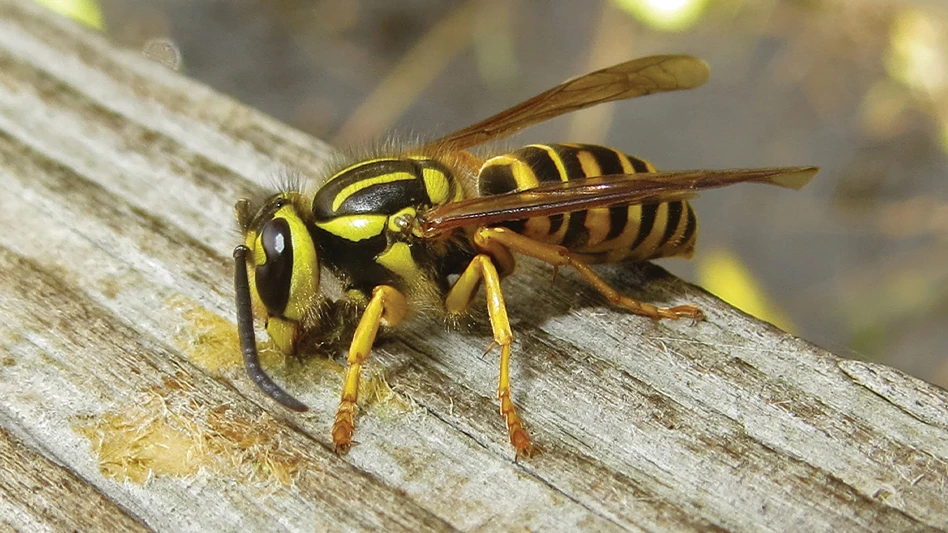
Courtesy Gerald Wegner
Editor’s Note: This article was adapted from Pinto & Associates.
A yellowjacket nest inside a home or other structure can be an especially troublesome problem. Vacuuming can be an effective control option that can be accomplished by following the right procedures.
Locate the nest.
Once you find the opening where yellowjackets are entering a building, you still need to locate the actual nest. It can be close to the entrance or up to 20 feet away. You can use a stethoscope to listen for buzzing, an acoustic emission detection device, a moisture meter or thermal imaging to locate the nest within the walls. Void nests can be in ceiling or wall voids, attics, behind fascia boards or soffits, in hollow cinder blocks or in other miscellaneous voids.
Openings into living areas.
Once you’ve found the nest, survey inside the building in that area, looking for any openings that yellowjackets could use to emerge from the nest void. Trapped wasps will try to escape their void area once insecticides are applied or if their entrance is blocked. They will use existing openings, or will chew through wallboard or ceilings to get out of the void. If you find dead yellowjackets on windowsills or in light fixtures, this is a clue that they are not restricted to the void area and could get into living areas or into drop ceilings, vents or ducts. Block off any access points into living spaces.
Just before you are ready to begin control measures, block off any secondary yellowjacket entry points, leaving the main entry into the nest open.
Vacuum for control.
Many PMPs vacuum yellowjackets from the nest entrance to reduce the overall numbers before pesticides are applied. A canister-type vacuum is generally easier to handle and has a longer hose. Or you can use a shop vac, placing a couple of inches of water and some dish soap in the canister before you begin. Wear long sleeves, long pants and gloves, and start with a new vacuum bag and a new filter. Some PMPs vacuum the yellowjackets into a plastic bottle or some kind of an inline trap system instead of directly into a vacuum bag.
Prop or tape the vacuum hose end into position within 2 inches of the entrance and leave the vacuum running for about an hour or until activity has dropped off. You will be sucking up yellowjackets both as they leave and as they enter the nest. Depending on the size of the nest, you can repeat the vacuuming later in the day or the next day. If your customer does not want pesticides used, vacuuming alone is an option that will need to be repeated weekly as new wasps develop from larvae and pupae in the nest.
When you’ve finished vacuuming, you should vacuum up a couple of tablespoons of sand, cornstarch or desiccant dust (but not if using a shop vac) to incapacitate the yellowjackets in the vacuum bag. Then tape or stuff the hose end closed and either place the vacuum in a black plastic bag and let it sit in the sun for a day to kill the wasps, or with the motor still running, open the canister and tape over the bag opening. Turn off the motor, remove the vacuum bag and place it in a zipper storage bag and place that in a freezer to kill the yellowjackets.
Treat the nest.
If possible, treat the nest when the building will be unoccupied for a couple of days after treatment. Wear appropriate clothing, gloves and ideally, a bee veil. Apply pesticides on a cool night, if possible, when most wasps are in the nest.
You can inject insecticide directly into the entrance hole, but this may not be effective if the nest is some distance from the opening. A better method is to drill a small hole directly into the nest (assuming you know its location) from inside the structure and inject the insecticide. A residual insecticide dust is probably your best choice since it will penetrate further into the void and will be carried to the nest by returning workers. Avoid using pyrethrins or pyrethroid products since these are particularly irritating to yellowjackets and may flush them into living areas. Seal your interior drill hole after treatment, but leave the outside entrance hole open so any returning yellowjackets will come in contact with the insecticide.
Follow up.
Wait a couple of days after treatment or until just before the building is reoccupied to make sure that there are no live yellowjackets inside rooms or in drop ceilings.
Don’t seal the main entrance into a yellowjacket void nest until the nest has been confirmed as dead or has been removed. Whether or not the nest should be removed from the void depends on several variables. If the nest remains in the void, seal the opening to keep out other insect scavengers such as dermestid beetles and silverfish.
The authors are well-known industry consultants and co-owners of Pinto & Associates.

Explore the August 2013 Issue
Check out more from this issue and find your next story to read.